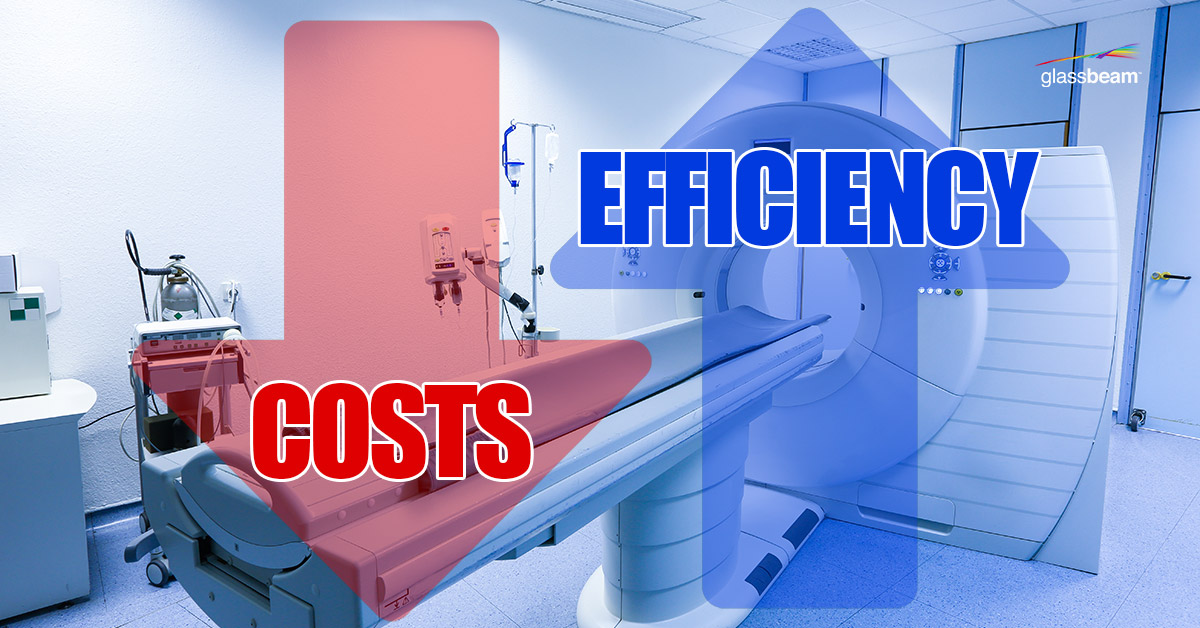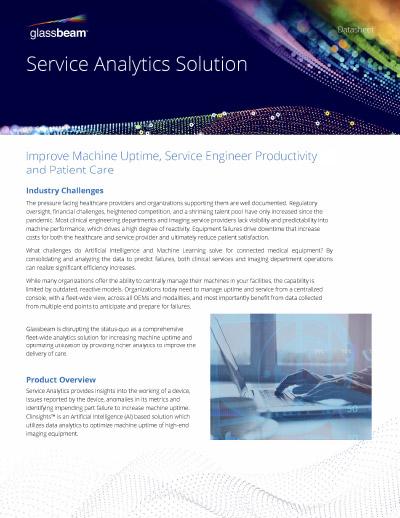
Radiology Equipment Maintenance: Reducing Cost and Improving Efficiency
As imaging reimbursement rates continue to decline, many radiology leaders are under pressure to reduce the total cost of owning and operating imaging equipment. In this budget-conscious environment, analyzing your equipment maintenance needs is a foundational step toward taking cost-cutting measures.
A single new CT scanner may cost $2M and an MRI scanner can cost $3M or more. While the purchase price of these assets is high, it is only the beginning of the total cost of ownership. Construction, upgrades, supplies, staffing, and ongoing maintenance is a significant portion of a radiology department’s annual expense.
The estimated global market in 2021 – just for maintaining medical imaging equipment – was $16.2 billion. The compound growth rate of this market is projected to be 6.1% from 2021 to 2031. A typical medium-sized facility may allocate $5 million annually for medical equipment maintenance, while an average healthcare system can incur annual costs of around $50 million.
Missed Savings on Radiology Equipment Maintenance
Becker’s CFO Report estimates that hospitals miss as much as 16% of savings on equipment lifecycle costs because they don’t have complete and accurate information, adequate internal resources, or the specialized expertise required to analyze data and minimize spend. This missed savings opportunity can equate to an average of $12,000 per hospital bed per year.
Full-service maintenance for a single CT or MRI machine can cost over $100,000 annually. Many imaging devices require frequent maintenance that can warrant an annual full-service contract. However, full-service agreements on newer or more dependable machines can be particularly profitable. For Example, repairs for nuclear medicine equipment may be less frequent and less expensive. A nuclear medicine department may be able to save money by having the equipment serviced based on time and materials only.
Case in Point: Harvard Medical reports that over 80 million CT scans are performed each year in the US. With that level of utilization, it may be more important to purchase full-service contracts for their busy CT scanners, compared to a SPECT gamma camera system, which is one of the least used systems in radiology.
Maintenance Service Providers (MSP) offer various service contract models, but they don’t typically provide the historical or device data that a radiology department needs to make good decisions about maintenance agreements. MSPs often encourage full-service contracts in which they can sometimes earn 30 – 50% profit margins.
The Enemies: Fear, Uncertainty, and Doubt
If a critical piece of imaging equipment is not operating properly, it can cause downtime, delays in diagnosis, and workflow disruption. The fear of downtime drives many radiology facilities to purchase full-service maintenance contracts without evaluating all the options. Over time, this approach can lead to spending more on maintenance than the purchase price of the machine itself. This raises important questions:
- Are you getting your money’s worth from your service contracts?
- Should you reevaluate the need for full-service contracts on your imaging equipment?
- Would it be reasonable to assume some risk on maintaining your highly reliable assets?
Case in point: According to Fierce Healthcare, a large medical center in the Midwest had spent more than $300,000 in equipment maintenance, and later realized they weren’t even certain the equipment existed.
The way to combat fear, uncertainty, and doubt about imaging equipment maintenance is to take a data-based approach to analysis and decision-making.
Making Data-Based Decisions

Overall, maintenance costs can vary significantly. One survey of 19 large hospitals showed that the average cost-of-service percentage was 7.4%. Another source says that for their organization, “Outsourced contracts ran at an annual cost-of-service percentage of 10% to 14% of the equipment’s cost. Third-party service contracts averaged 8.3%, insurance coverage averaged 7.4%, and a combination that relied mainly on in-house service ranged from 4% to 6%.”
Taking On Some Risk – Intelligently
One option, for appropriate equipment, is to pay for service and parts as needed. You can create a “risk pool” of money, based on historical service needs, to pay for service. With the proper information, you can use different service options for individual machines, rather than taking a one-size-fits-all approach.
One hospital cited, “In most cases, we saved 30% or more by buying from a parts distributor, not the OEM… Before we implemented our in-house program, our cost-of-service percentage was close to 12%. After our first year of the program (with a mix of options), our cost-of-service percentage dropped to 6%. By the second year, it was down to 4%.”
Performance to SLAs: Response Time, Uptime, and Reliability
Before you make maintenance agreement decisions, evaluate the performance factors against service level agreements (SLAs).
- Consider the response time.
A prompt response to any service request can help minimize downtime and operational interruptions, especially for frequently used equipment. The cost of higher response time should be weighed against the system utilization and availability of backup. - Understand the level of uptime for each imaging device.
High uptime indicates reliable and efficient operation. Machines that consistently maintain optimal uptime and minimal downtime may not require a full-service contract. This should also be a key consideration for both future purchase decisions and during service contract negotiations. - Review the frequency and severity of service events.
Devices with minimal maintenance needs may not require full-service agreements. By analyzing the historical data, you can make informed decisions.
Extended Hours of Coverage: Assessing the Need for Longer Support
Analyze historical data and identify patterns of service utilization to determine whether you need service support beyond regular business hours. Examining the frequency and severity of service events that occur outside standard operating hours will provide you with valuable insights.
If your facility rarely experiences service issues during evenings, weekends, or holidays, you may find that standard coverage is sufficient. Analyzing the historical data also helps identify any critical timeframes or equipment that consistently requires extended coverage.
Assess Your Backup Device Risk
Analyze your utilization patterns, including frequency and duration of usage, to understand the full workload of each device. In your analysis, consider your backup device availability. If you have backup imaging equipment to allocate, you can lower the risk of service disruptions and take a more flexible approach to maintenance contracts, potentially leading to cost savings.
Machines without backup devices and high utilization rates may warrant full-service contracts with high SLAs to ensure consistent performance and minimize downtime that could impact patient care.
Reliability: Retiring, Replacing, or Investing in Used Assets
Machines with a high number of service events may require expensive full-service contracts. In such cases, assess the long-term cost of continued maintenance versus the cost of purchasing and maintaining new or refurbished assets.
Retiring and replacing unreliable assets with newer models is sometimes the more cost-effective solution. The National Library of Medicine states, “Equipment older than 10 years is no longer state-of-the art equipment and replacement is essential. Operating costs of older equipment will be high when compared with new equipment, and sometimes maintenance will be impossible if no spare parts are available.”
Be sure to know the age of your equipment and plan when to retire it. The National Library of Medicine recommends, “…at least 60% of the installed equipment in radiology departments should be up to 5 years old. Up to 30% should be 6-10 years old, whereas not more than 10% of equipment should be older than 10 years.” When looking for replacement equipment, pre-owned assets with a track record of reliability and low maintenance cost can be an opportunity for cost savings.
With thorough cost analysis and planning, you can optimize your equipment fleet and ensure that your maintenance approach aligns with your budget and operational needs.
Visibility to All Your Assets
Lack of transparency in equipment maintenance inhibits informed decision-making. Over 83% of providers claim to have no automated visibility into their devices. Without the needed equipment data, opting for pay-as-you-go maintenance can be truly risky.
A data analytics solution can enhance your insight into your equipment’s key performance indicators. By understanding the full cost, utilization and reliability of your equipment, you can make well-informed decisions about maintenance support and capital planning, potentially resulting in significant savings.
Download the Glassbeam Service Analytics Overview
Data Analysis Solutions: In-House vs. Automated
Medical facilities can create their own asset database to track lifecycle costs, reliability and service performance for each piece of equipment. Data analytics should include past service event details, contract and non-contract costs, performance trends, and more. However, manual investigation may leave causes of failure or underperformance indicators undiscovered.
Data analytics solutions from Glassbeam provide predictive and prescriptive insights to maximize uptime, asset utilization and optimize service costs of medical imaging equipment.
Data analytics can help you track repairs and other costs during the complete lifecycle of your imaging equipment. Consolidated usage data by equipment type and facility can help you reduce operational expense, increase patient access and develop a data-informed asset replacement strategy.
Shift Your Service Model Mix – Purposefully
Changing your service model mix can be daunting, but with full visibility into the data, you can gain confidence. Ensure you understand your imaging assets’ costs and trending service levels. Then you can shift from automatically purchasing full-service agreements to a more deliberate and customized approach.
MSPs offer various service contract options, but they don’t typically provide the data required to make well-informed decisions. Glassbeam’s platform fills this gap by organizing essential financial, operational and performance information, enabling visual and analytics based insights to better manage your operations and meet budget obligations.
Explore the Possibilities
With more than 1 million exams examined each day by Glassbeam solutions, see how top organizations are transforming their log data into impactful insights.
Transform Your Healthcare Operations
See how to gain deeper, clearer insight from your machine data to elevate business intelligence and to improve your operational uptime, utilization, and efficiency.
